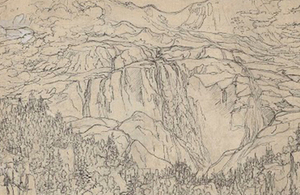18th century drawing of Schmadribach Waterfall at risk of leaving the UK
Arts Minister steps in to prevent rare study from export.

The Schmadribach Waterfall by Joseph Anton Koch (detail)
A drawing of the Schmadribach Waterfall is at risk of being exported from the UK unless a buyer can be found to match the asking price of £68,750.
Arts Minister John Glen has placed a temporary export bar on the drawing, by Austrian Romantic artist Joseph Anton Koch, to provide an opportunity to keep it in the country.
The preparatory study was made for J.A. Koch’s most celebrated composition, The Schmadribach Waterfall near Lauterbrunnen, which is famed for its spectacular scenery.
Dating from around 1793, the work is typical of the highly precise studies Koch made for compositions, using black chalk and heightening the contours in black ink.
The drawing is an important work by a major figure of early 19th century painting. Koch’s depictions of Switzerland were extremely influential and helped to popularise Alpine scenery among European artists.
He was especially popular with British collectors during his lifetime, but only seven of his drawings remain in UK public collections.
Arts Minister John Glen said:
This striking study for Joseph Anton Koch’s most celebrated landscape shows why this leading Romantic painter was so highly regarded by British artists.
I hope that a buyer comes forward to help keep it in the UK so that more people can learn about this artist’s creative process and the development of his art.
The decision to defer the export licence follows a recommendation by the Reviewing Committee on the Export of Works of Art and Objects of Cultural Interest (RCEWA), administered by The Arts Council.
RCEWA member Lowell Libson said:
Joseph Anton Koch is a pivotal figure in the European Romantic movement at the turn of the eighteenth and nineteenth centuries and enjoyed a significant relationship with British patrons and collectors who particularly appreciated his ‘heroic’ Alpine landscapes.
Very few of Koch’s many important works originally in British collections now remain in the UK. This unusually highly elaborate drawing was made in preparation for the painting that is considered to be his masterpiece.
The retention in this country of this beautiful and important drawing would greatly add to the way in which British institutions can tell the story of European Romanticism and of the development of British taste and patronage.
The RCEWA made its recommendation on the grounds of the drawing’s outstanding significance for the study of Romantic landscape art and Swiss scenery.
The decision on the export licence application for the drawing will be deferred until 27 September 2017. This may be extended until 27 December 2017 if a serious intention to raise funds to purchase it is made at the recommended price of £68,750 (plus VAT of £2,750).
Organisations or individuals interested in purchasing the drawing should contact the RCEWA on 0845 300 6200.
An image of the drawing can be downloaded via our flickr site
ENDS
For media information contact: Yasmin Kaye Communications Officer Department for Culture Media and Sport Tel: 0207 211 6489 Email: [email protected]
Notes to editors
- Details of the drawing are as follows: The Schmadribach Waterfall near Lauterbrunnen, Switzerland A faint sketch of a mountainous landscape Black chalk, pen and black ink, lightly squared in black chalk, indented for transfer, 44.3 x 35.8cm (17 ½ x 14 1/8 in.) Dated around 1793 The drawing is un-faded and in good condition for a work of its date and technique
- Collection of Brian Sewell (1931-2015); his sale, Christies, King Street, London, 27 September 2016, lot 60 (estimate £20,000-30,000); sold at £68,750.
- The Reviewing Committee on the Export of Works of Art and Objects of Cultural Interest is an independent body, serviced by The Arts Council, which advises the Secretary of State for Culture, Media and Sport on whether a cultural object, intended for export, is of national importance under specified criteria.
- The Arts Council champions, develops and invests in artistic and cultural experiences that enrich people’s lives. It supports a range of activities across the arts, museums and libraries – from theatre to digital art, reading to dance, music to literature, and crafts to collections. www.artscouncil.org.uk.